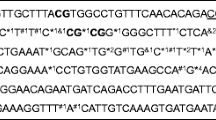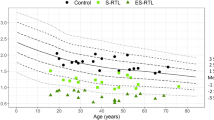Abstract
Chromosome translocations are especially frequent in human lymphomas and leukemias but are insufficient to drive carcinogenesis. Indeed, several of the so-called tumor specific translocations have been detected in peripheral blood of healthy individuals, finding a higher frequency of some of them with aging. The inappropriate repair of DNA double strand breaks by the nonhomologous end joining (NHEJ) pathway is one of the reasons for a translocation to occur. Moreover, fidelity of this pathway has been shown to decline with age. Although the mechanism underlying this inefficacy is unknown, other repair pathways are inactivated by methylation with aging. In this study, we analyzed the implication of NHEJ genes methylation in the increase of translocations with the age. To this aim, we determined the relationship between translocations and aging in 565 Spanish healthy individuals and correlated these data with the methylation status of 11 NHEJ genes. We found higher frequency of BCL2-JH and BCR-ABL (major) translocations with aging. In addition, we detected that two NHEJ genes (LIG4 and XRCC6) presented age-dependent promoter methylation changes. However, we did not observe a correlation between the increase of translocations and methylation, indicating that other molecular mechanisms are involved in the loss of NHEJ fidelity with aging.


Similar content being viewed by others
References
Ahnesorg P, Smith P, Jackson SP (2006) XLF interacts with the XRCC4-DNA ligase IV complex to promote DNA nonhomologous end-joining. Cell 124(2):301–313
Bäsecke J, Griesinger F, Trümper L, Brittinger G (2002) Leukemia- and lymphoma-associated genetic aberrations in healthy individuals. Ann Hematol 81(2):64–75
Biernaux C, Loos M, Sels A, Huez G, Stryckmans P (1995) Detection of major bcr-abl gene expression at a very low level in blood cells of some healthy individuals. Blood 86(8):3118–3122
Bose S, Deininger M, Gora-Tybor J, Goldman JM, Melo JV (1998) The presence of typical and atypical BCR-ABL fusion genes in leukocytes of normal individuals: biologic significance and implications for the assessment of minimal residual disease. Blood 92(9):3362–3367
Brassesco MS (2008) Leukemia/lymphoma-associated gene fusions in normal individuals. Genet Mol Res 7(3):782–790
Brassesco MS, Montaldi AP, Gras DE, de Paula Queiroz RG, Martinez-Rossi NM, Tone LG, Sakamoto-Hojo ET (2009) MLL leukemia-associated rearrangements in peripheral blood lymphocytes from healthy individuals. Genet Mol Biol 32(2):234–241
Buck D, Malivert L, de Chasseval R, Barraud A, Fondanèche MC, Sanal O, Plebani A, Stéphan JL, Hufnagel M, le Deist F, Fischer A, Durandy A, de Villartay JP, Revy P (2006) Cernunnos, a novel nonhomologous end-joining factor, is mutated in human immunodeficiency with microcephaly. Cell 124(2):287–299
Christensen BC, Houseman EA, Marsit CJ, Zheng S, Wrensch MR, Wiemels JL, Nelson HH, Karagas MR, Padbury JF, Bueno R, Sugarbaker DJ, Yeh RF, Wiencke JK, Kelsey KT (2009) Aging and environmental exposures alter tissue-specific DNA methylation dependent upon CpG island context. PLoS Genet 5(8):e1000602
Dölken G, Dölken L, Hirt C, Fusch C, Rabkin CS, Schüler F (2008) Age-dependent prevalence and frequency of circulating t(14;18)-positive cells in the peripheral blood of healthy individuals. J Natl Cancer Inst Monogr 39:44–47
Doria G, Barattini P, Scarpaci S, Puel A, Guidi L, Frasca D (2004) Role of immune responsiveness and DNA repair capacity genes in ageing. Ageing Res Rev 3(2):143–151
Fraga MF, Esteller M (2007) Epigenetics and aging: the targets and the marks. Trends Genet 23(8):413–418
Gorbunova V, Seluanov A (2005) Making ends meet in old age: DSB repair and aging. Mech Ageing Dev 126(6–7):621–628
Greaves M (2003) Pre-natal origins of childhood leukemia. Rev Clin Exp Hematol 7(3):233–245
Janz S, Potter M, Rabkin CS (2003) Lymphoma- and leukemia-associated chromosomal translocations in healthy individuals. Gene Chromosome Cancer 36(3):211–223
Ju YJ, Lee KH, Park JE, Yi YS, Yun MY, Ham YH, Kim TJ, Choi HM, Han GJ, Lee JH, Lee J, Han JS, Lee KM, Park GH (2006) Decreased expression of DNA repair proteins Ku70 and Mre11 is associated with aging and may contribute to the cellular senescence. Exp Mol Med 38(6):686–693
Karanjawala ZE, Lieber MR (2004) DNA damage and aging. Mech Ageing Dev 125(6):405–416
Lee Y, McKinnon PJ (2007) Responding to DNA double strand breaks in the nervous system. Neuroscience 145(4):1365–1374
Lieber MR (2010) The mechanism of double-strand DNA break repair by the nonhomologous DNA end-joining pathway. Annu Rev Biochem 79:181–211
Liu Y, Hernandez AM, Shibata D, Cortopassi GA (1994) BCL2 translocation frequency rises with age in humans. Proc Natl Acad Sci U S A 91(19):8910–8914
Maes B, Vanhentenrijk V, Wlodarska I, Cools J, Peeters B, Marynen P, de Wolf-Peeters C (2001) The NPM-ALK and the ATIC-ALK fusion genes can be detected in non-neoplastic cells. Am J Pathol 158(6):2185–2193
Mani RS, Chinnaiyan AM (2010) Triggers for genomic rearrangements: insights into genomic, cellular and environmental influences. Nat Rev Genet 11(12):819–829
Marín C, Martínez-Delgado B, Meléndez B, Larrayoz MJ, Martínez-Ramírez A, Robledo M, Cigudosa JC, Calasanz MJ, Benítez J (2001) Multiplex-polymerase chain reaction assay for the detection of prognostically significant translocations in acute lymphoblastic leukemia. Haematologica 86(12):1254–1260
Martín-Subero JI, Kreuz M, Bibikova M, Bentink S, Ammerpohl O, Wickham-Garcia E, Rosolowski M, Richter J, Lopez-Serra L, Ballestar E, Berger H, Agirre X, Bernd HW, Calvanese V, Cogliatti SB, Drexler HG, Fan JB, Fraga MF, Hansmann ML, Hummel M, Klapper W, Korn B, Küppers R, Macleod RA, Möller P, Ott G, Pott C, Prosper F, Rosenwald A, Schwaenen C, Schübeler D, Seifert M, Stürzenhofecker B, Weber M, Wessendorf S, Loeffler M, Trümper L, Stein H, Spang R, Esteller M, Barker D, Hasenclever D, Siebert R, Krebshilfe MMMLNPD (2009) New insights into the biology and origin of mature aggressive B-cell lymphomas by combined epigenomic, genomic, and transcriptional profiling. Blood 113(11):2488–2497
Nambiar M, Raghavan SC (2010) Prevalence and analysis of t(14;18) and t(11;14) chromosomal translocations in healthy Indian population. Ann Hematol 89(1):35–43
Nambiar M, Raghavan SC (2012) Mechanism of fragility at BCL2 gene minor breakpoint cluster region during t(14;18) chromosomal translocation. J Biol Chem 287(12):8688–8701
Nambiar M, Raghavan SC (2013) Chromosomal translocations among the healthy human population: implications in oncogenesis. Cell Mol Life Sci 70(8):1381–1392
Neves H, Ramos C, da Silva MG, Parreira A, Parreira L (1999) The nuclear topography of ABL, BCR, PML, and RARalpha genes: evidence for gene proximity in specific phases of the cell cycle and stages of hematopoietic differentiation. Blood 93(4):1197–1207
O’Driscoll M, Cerosaletti KM, Girard PM, Dai Y, Stumm M, Kysela B, Hirsch B, Gennery A, Palmer SE, Seidel J, Gatti RA, Varon R, Oettinger MA, Neitzel H, Jeggo PA, Concannon P (2001) DNA ligase IV mutations identified in patients exhibiting developmental delay and immunodeficiency. Mol Cell 8(6):1175–1185
Parada L, Misteli T (2002) Chromosome positioning in the interphase nucleus. Trends Cell Biol 12(9):425–432
Rabkin CS, Hirt C, Janz S, Dölken G (2008) t(14;18) Translocations and risk of follicular lymphoma. J Natl Cancer Inst Monogr 39:48–51
Roix JJ, McQueen PG, Munson PJ, Parada LA, Misteli T (2003) Spatial proximity of translocation-prone gene loci in human lymphomas. Nat Genet 34(3):287–291
Roulland S, Kelly RS, Morgado E, Sungalee S, Solal-Celigny P, Colombat P, Jouve N, Palli D, Pala V, Tumino R, Panico S, Sacerdote C, Quirós JR, Gonzáles CA, Sánchez MJ, Dorronsoro M, Navarro C, Barricarte A, Tjønneland A, Olsen A, Overvad K, Canzian F, Kaaks R, Boeing H, Drogan D, Nieters A, Clavel-Chapelon F, Trichopoulou A, Trichopoulos D, Lagiou P, Bueno-de-Mesquita HB, Peeters PH, Vermeulen R, Hallmans G, Melin B, Borgquist S, Carlson J, Lund E, Weiderpass E, Khaw KT, Wareham N, Key TJ, Travis RC, Ferrari P, Romieu I, Riboli E, Salles G, Vineis P, Nadel B (2014) t(14;18) Translocation: a predictive blood biomarker for follicular lymphoma. J Clin Oncol 32(13):1347–1355
Schüler F, Hirt C, Dölken G (2003) Chromosomal translocation t(14;18) in healthy individuals. Semin Cancer Biol 13(3):203–209
Schüler F, Dölken L, Hirt C, Kiefer T, Berg T, Fusch G, Weitmann K, Hoffmann W, Fusch C, Janz S, Rabkin CS, Dölken G (2009) Prevalence and frequency of circulating t(14;18)-MBR translocation carrying cells in healthy individuals. Int J Cancer 124(4):958–963
Seluanov A, Mittelman D, Pereira-Smith OM, Wilson JH, Gorbunova V (2004) DNA end joining becomes less efficient and more error-prone during cellular senescence. Proc Natl Acad Sci U S A 101(20):7624–7629
Seluanov A, Danek J, Hause N, Gorbunova V (2007) Changes in the level and distribution of Ku proteins during cellular senescence. DNA Repair (Amst) 6(12):1740–1748
Thompson RF, Atzmon G, Gheorghe C, Liang HQ, Lowes C, Greally JM, Barzilai N (2010) Tissue-specific dysregulation of DNA methylation in aging. Aging Cell 9(4):506–518
Yan CT, Boboila C, Souza EK, Franco S, Hickernell TR, Murphy M, Gumaste S, Geyer M, Zarrin AA, Manis JP, Rajewsky K, Alt FW (2007) IgH class switching and translocations use a robust non-classical end-joining pathway. Nature 449(7161):478–482
Zhen C, Wang YL (2013) Molecular monitoring of chronic myeloid leukemia: international standardization of BCR-ABL1 quantitation. J Mol Diagn 15(5):556–564
Acknowledgments
This project was supported by the Basque Government (IT661-13), UPV/EHU (UFI11/35), and RTICC (RD12/0036/0060, RD12/0036/0036)
Conflict of interest
All the authors declare no conflict of interest.
Author information
Authors and Affiliations
Corresponding author
Electronic supplementary material
Below is the link to the electronic supplementary material.
ESM 1
(DOC 75 kb)
About this article
Cite this article
Martín-Guerrero, I., de Prado, E., Lopez-Lopez, E. et al. Methylation of the nonhomologous end joining repair pathway genes does not explain the increase of translocations with aging. AGE 36, 9730 (2014). https://doi.org/10.1007/s11357-014-9730-4
Received:
Accepted:
Published:
DOI: https://doi.org/10.1007/s11357-014-9730-4




